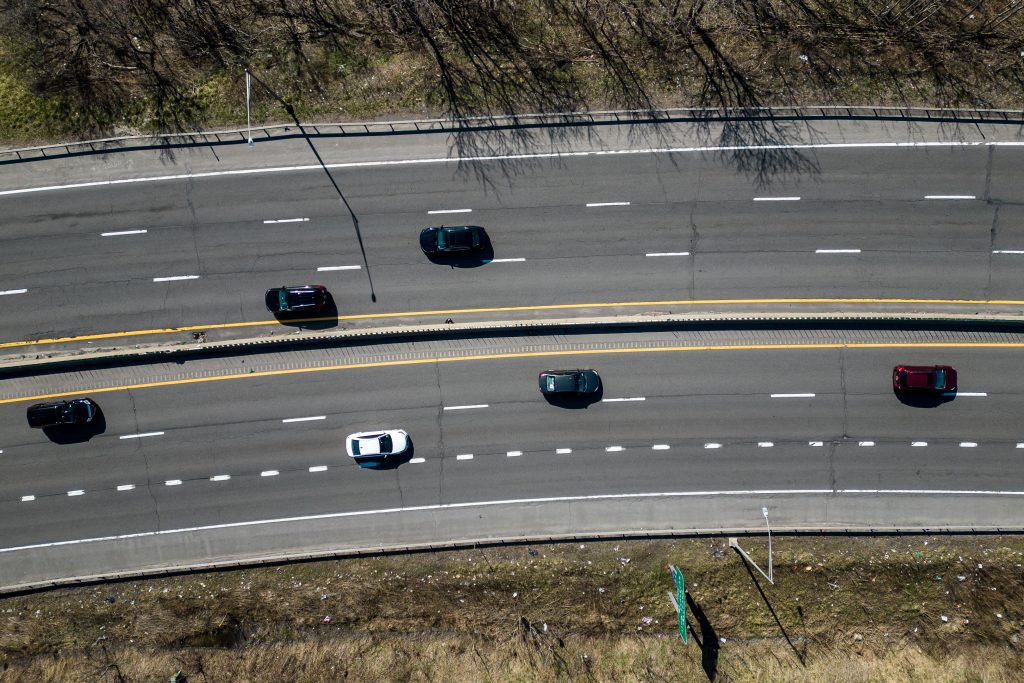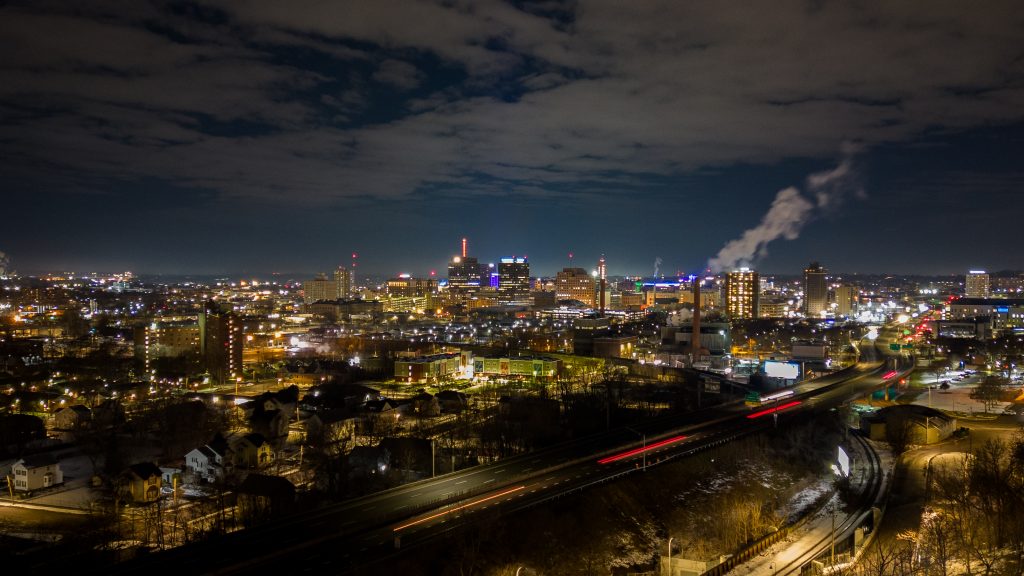
A Tale of Tailpipes
Replace or remove: which option for Interstate 81 is best for the environment?

act: The construction of Interstate 81 displaced 1,300 mostly Black city residents and left those who remained at greater risk of asthma and lead poisoning.
Also fact: The current plan to divert traffic around the city adds extra miles for drivers passing through the area and will potentially push heavier traffic into the suburbs.
Opposing facts like those make it easy to see why groups on both sides of the debate over the future of I-81 claim to have the environmental high ground.
Syracuse has been talking about what to do with the elevated highway that split the city in two since at least 2006, when city officials started noting that maintenance efforts couldn’t keep pace with the interstate’s deterioration. The city never wanted the highway that plowed through the 15th Ward and Downtown in the 1960s. And it has watched as other cities, including San Francisco and Milwaukee, saw property values rise after they tore down highways.
In the 17 years since removing the highway became a public conversation, the debate has been anything but easy. People invested in the city and who believe in the current best practices embraced by urban planners generally want to see the highway torn down, the grid of city streets the highway destroyed rebuilt, and traffic that intends to whiz through the city diverted around Syracuse via Interstate 481.
Suburban interests who fear traffic patterns would shift in their direction, truck drivers looking for the fastest route through the city, and businesses like DestinyUSA that are easily accessible from I-81 don’t like the idea. They want to see the highway rebuilt or replaced by another route through the city, such as a tunnel or sky bridge.
Meanwhile, the highway continues to crumble. Engineers determined that the useful life of the 1.4-mile viaduct expired in 2017. Studies and community meetings examined various solutions, with the city, state and federal governments all concluding that removing the viaduct and replacing it with the community grid was the only viable option. The plan was finalized in April 2022.
But that has not ended the debate. A new organization, Renew 81 for All, formed earlier this year to challenge the plan in court. In its lawsuit, the organization claims the viaduct project violated the New York Climate Law and Green Amendment by not considering what it said would be an increase in traffic and greenhouse gas emissions. In court, the group would also argue how the announcement of Micron, a microchip company planning to create thousands of jobs in the area, should be taken into account.
“There are two major problems I see,” said Renew 81 lead attorney Alan Knauf. “One is that their own logic and study was bad to begin with. And now, with the Micron project, it’s stale. It’s got to be redone anyways, but their logic just makes no sense. They want to route people around Syracuse, which is going to add vehicle miles, which causes more pollution.”
The suit states, “the project would result in traffic delays and backups (making the Community Grid into Community Gridlock), force trucks to divert an extra 8 to 22 miles around the City of Syracuse, or through local streets, and cause numerous unmitigated but avoidable negative environmental impacts.”
That argument put the project’s environmental review in question, and Renew81 asked for it to be thrown out and redone. The group said the review failed to consider detrimental environmental concerns and never provided alternative solutions that might have “less adverse environmental impacts.”

Multiple environmental experts disagree. David Driesen, a Syracuse professor specializing in environmental law, said Renew 81 is leaning on “reverse environmental justice claims.” He said the group is leaning on environmental claims to justify reconstructing I-81 when it’s disproportionately affecting marginalized communities.
Four experts concluded the state’s environmental review, conducted over a 9-year period, was thorough and complete.
They also poked holes in Knauf’s arguments that tearing down the highway might increase emissions since vehicles driving through the city will do so at slower speeds when the highway is gone. But the experts note that traffic on 481, with wider lanes than the current 81 and a new 70 mph speed limit, will travel faster. Traffic in the city, meanwhile, will be spread over a larger number of streets as the original city grid is repaired. That could make for shorter and faster travel times.
John Stehlin, who specializes in sustainable urbanism, called Knauf’s claims “a pretty common tactic,” and one that has been debunked. Stehlin cited efforts to stop the San Francisco Bike Plan, where opponents delayed the environmental review by claiming the plan would snarl traffic by taking away car lanes. Opponents of the bike plan said it would create more emissions from cars that would be forced to travel slower due to more bikes on the road. A resulting extensive review found that the difference was negligible.
“It’s a pretty common tactic in groups that oppose mobility changes for reasons having nothing to do with the environment,” Stehlin said. “To me, historically when I’ve looked at these issues, that’s been sort of a red herring, and a somewhat intentional one.”
When finished, will tearing down the highway cut time from your commute, or lengthen it? Will it increase traffic in your neighborhood, or decrease it? That may well depend on where, precisely, you live in Central New York and where you are heading.
Experts like Timur Hammond, an SU professor specializing in urban geography, says planners should prioritize the people who have been most negatively impacted by the highway to begin with. Broadly speaking, the most polluted areas have the most people of color, he said. Wealthier people who live in the suburbs would prefer if that pollution was concentrated in poorer areas — as it has been since I-81’s construction, Hammond said.
“One of the subtexts of the Renew-81 lawsuit is that they’re totally happy to continue a status quo where I-81 continues to inflict harm on some of the marginalized populations in the region,” Hammond said. “So that’s something that geographers and others call an instance of environmental racism.”
Renew-81 was successful in November when the county’s supreme court halted the project and issued a court injunction preventing construction from starting on the highway. But only a few months later in February, State Supreme Court Justice Gerard Neri allowed the project to continue, confirming the viaduct will still be torn down.
The court decided Renew 81 “failed to establish deficiencies in (the environmental impact statement) analyses, including for greenhouse gas emissions.” Neri does not support the environmental claims of Renew 81, but did conclude the environmental review failed to consider three important factors: How increased traffic will impact the area, a final and sufficient plan for stormwater management and the impact of Micron.
“We were satisfied with it; it didn’t give us everything we were looking for,” Knauf said.
Lemir Teron, an ESF professor specializing in environmental justice, said that it’s always best to be using the most updated information while conducting a thorough environmental review. But, he added, at a certain point, the project needs to move forward.
“Are you going to keep stalling and each time, are you going to play the same game? Well, let’s go back and get more,” Teron said. “You’ve heard the phrase, ‘paralysis by analysis.’ Essentially, that’s what this is.”
The development with Micron’s added jobs doesn’t mean restarting the entire environmental review, said Hammond. They’re right to reconsider the effect that Micron will have on the broader region, but he agrees with Teron.
“I do think that it is partly a sort of strategic decision by the Renew-81 group just to tie things up further in courts,” Hammond said.
Judge Neri also ordered the state to study how, if the I-81 viaduct is removed, diverting traffic to Interstate 481 could cause new air pollution in suburban areas.
Highways divide communities, urban geographers say. I-81 was constructed with almost all federal funds on cheap land that stemmed from redlining, Stehlin said.
“The use of a highway to demolish what officials considered a ‘slum’ became an attractive option,” Stehlin said, referencing a nationwide trend at the time.
One resident described the viaduct as Syracuse’s “Berlin Wall” in a 2012 interview with NPR. In addition to adverse pollution effects and increased rates of asthma as a result, there’s noise pollution, and the disconnection and isolation of neighborhoods.
“Is it a good idea to remove an Interstate that’s literally built on top of a predominantly Black community and has punished that community environmentally, for decades? Absolutely,” Teron said.

The project shouldn’t end with a community grid though, environmental experts warn. Taking down the highway should be part of a broader strategy, Stehlin said.
Removing the Interstate should be part of a “mobility transition” — not just rerouting existing traffic, but thinking about public transportation and development patterns as well. That transition should help decrease car dependency “so the people who still need to drive (longer distances) will not be competing against the people who really are just going one mile,” Stehlin said.
The community grid addresses the problem at a local level, Stehlin said. And it’s the more environmentally sustainable option, Teron added.
“But that doesn’t mean that the end game is going to be synonymous with environmental justice,” Teron said.
“We have to think about the aftermath of what that community grid’s going to look like, who’s going to live in the community, who’s going to work in the community, who’s going to play in that community — it’s not inherently just, just because you have a community grid.”
